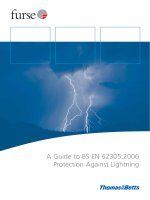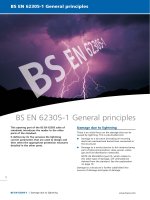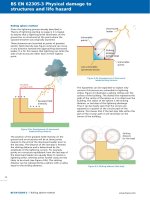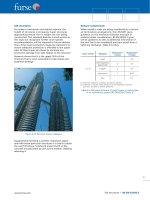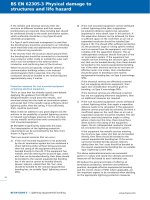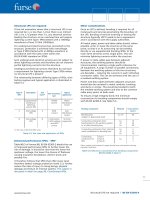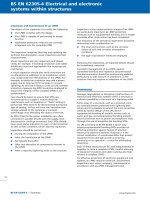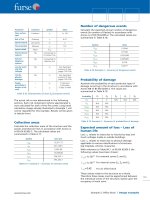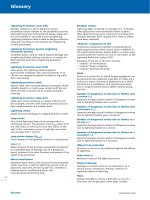Bsi bs en 00438 5 2016
Bạn đang xem bản rút gọn của tài liệu. Xem và tải ngay bản đầy đủ của tài liệu tại đây (984.09 KB, 14 trang )
BS EN 438-5:2016
BSI Standards Publication
High-pressure decorative
laminates (HPL) — Sheets
based on thermosetting resins
(usually called laminates)
Part 5: Classification and specifications for
flooring grade laminates less than 2 mm
thick intended for bonding to supporting
substrates
BS EN 438-5:2016
BRITISH STANDARD
National foreword
This British Standard is the UK implementation of EN 438-5:2016. It
supersedes BS EN 438-5:2005 which is withdrawn.
The UK participation in its preparation was entrusted to Technical
Committee PRI/76, Laminated sheet for decorative purposes.
A list of organizations represented on this committee can be
obtained on request to its secretary.
This publication does not purport to include all the necessary
provisions of a contract. Users are responsible for its correct
application.
© The British Standards Institution 2016. Published by BSI Standards
Limited 2016
ISBN 978 0 580 87154 2
ICS 83.140.20
Compliance with a British Standard cannot confer immunity from
legal obligations.
This British Standard was published under the authority of the
Standards Policy and Strategy Committee on 29 February 2016.
Amendments issued since publication
Date
Text affected
BS EN 438-5:2016
EN 438-5
EUROPEAN STANDARD
NORME EUROPÉENNE
EUROPÄISCHE NORM
February 2016
ICS 83.140.20
Supersedes EN 438-5:2005
English Version
High-pressure decorative laminates (HPL) - Sheets based
on thermosetting resins (usually called laminates) - Part 5:
Classification and specifications for flooring grade
laminates less than 2 mm thick intended for bonding to
supporting substrates
Stratifiés décoratifs haute pression (HPL) - Plaques à
base de résines thermodurcissables (communément
appelées stratifiés) - Partie 5: Classification et
spécifications des stratifiés pour revêtement de sols
d'épaisseur inférieure à 2 mm destinés à être collés sur
des supports
Dekorative Hochdruck-Schichtpressstoffplatten (HPL)
- Platten auf Basis härtbarer Harze (Schichtpressstoffe)
- Teil 5: Klassifizierung und Spezifikationen für
Schichtpressstoffe für Fbưden mit einer Dicke
kleiner 2 mm, vorgesehen zum Verkleben auf ein
Trägermaterial
This European Standard was approved by CEN on 13 December 2015.
CEN members are bound to comply with the CEN/CENELEC Internal Regulations which stipulate the conditions for giving this
European Standard the status of a national standard without any alteration. Up-to-date lists and bibliographical references
concerning such national standards may be obtained on application to the CEN-CENELEC Management Centre or to any CEN
member.
This European Standard exists in three official versions (English, French, German). A version in any other language made by
translation under the responsibility of a CEN member into its own language and notified to the CEN-CENELEC Management
Centre has the same status as the official versions.
CEN members are the national standards bodies of Austria, Belgium, Bulgaria, Croatia, Cyprus, Czech Republic, Denmark, Estonia,
Finland, Former Yugoslav Republic of Macedonia, France, Germany, Greece, Hungary, Iceland, Ireland, Italy, Latvia, Lithuania,
Luxembourg, Malta, Netherlands, Norway, Poland, Portugal, Romania, Slovakia, Slovenia, Spain, Sweden, Switzerland, Turkey and
United Kingdom.
EUROPEAN COMMITTEE FOR STANDARDIZATION
COMITÉ EUROPÉEN DE NORMALISATION
EUROPÄISCHES KOMITEE FÜR NORMUNG
CEN-CENELEC Management Centre: Avenue Marnix 17, B-1000 Brussels
© 2016 CEN
All rights of exploitation in any form and by any means reserved
worldwide for CEN national Members.
Ref. No. EN 438-5:2016 E
BS EN 438-5:2016
EN 438-5:2016 (E)
Contents
Page
European foreword....................................................................................................................................................... 3
1
Scope .......................................................................................................................................................................... 4
2
Normative references .......................................................................................................................................... 4
3
Terms and definitions, symbols and abbreviations.................................................................................. 5
4
5
3.1
3.2
Terms and definitions.................................................................................................................................................... 5
Symbols ............................................................................................................................................................................... 5
Classification system ............................................................................................................................................ 5
Requirements ......................................................................................................................................................... 6
5.1 Compliance......................................................................................................................................................................... 6
5.2 Inspection requirements .............................................................................................................................................. 6
5.2.1
General ........................................................................................................................................................................6
5.2.2
Colour and pattern ................................................................................................................................................. 6
5.2.3
Surface finish ............................................................................................................................................................ 6
5.2.4
Reverse side .............................................................................................................................................................. 7
5.2.5
Visual inspection ..................................................................................................................................................... 7
5.3 Dimensional tolerance requirements ..................................................................................................................... 7
5.4 Test requirements ........................................................................................................................................................... 8
5.4.1
General requirements ........................................................................................................................................... 8
5.4.2
Notes on requirements for reaction to fire ............................................................................................... 10
5.5 Supplemental properties........................................................................................................................................... 10
2
BS EN 438-5:2016
EN 438-5:2016 (E)
European foreword
This document (EN 438-5:2016) has been prepared by Technical Committee CEN/TC 249 “Plastics”, the
secretariat of which is held by NBN.
This European Standard shall be given the status of a national standard, either by publication of an
identical text or by endorsement, at the latest by August 2016, and conflicting national standards shall
be withdrawn at the latest by August 2016.
Attention is drawn to the possibility that some of the elements of this document may be the subject of
patent rights. CEN [and/or CENELEC] shall not be held responsible for identifying any or all such patent
rights.
This document supersedes EN 438-5:2005.
EN 438, High-pressure decorative laminates (HPL) — Sheets based on thermosetting resins (usually called
laminates), consists of the following parts:
— Part 1: Introduction and general information
— Part 2: Determination of properties
— Part 3: Classification and specifications for laminates less than 2 mm thick intended for bonding to
supporting substrates
— Part 4: Classification and specifications for Compact laminates of thickness 2 mm and greater
— Part 5: Classification and specifications for flooring grade laminates less than 2 mm thick intended for
bonding to supporting substrates
— Part 6: Classification and specifications for Exterior-grade Compact laminates of thickness 2 mm and
greater
— Part 7: Compact laminate and HPL composite panels for internal and external wall and ceiling finishes
— Part 8: Classification and specifications for design laminates
— Part 9: Classification and specifications for alternative core laminates
According to the CEN-CENELEC Internal Regulations, the national standards organizations of the
following countries are bound to implement this European Standard: Austria, Belgium, Bulgaria,
Croatia, Cyprus, Czech Republic, Denmark, Estonia, Finland, Former Yugoslav Republic of Macedonia,
France, Germany, Greece, Hungary, Iceland, Ireland, Italy, Latvia, Lithuania, Luxembourg, Malta,
Netherlands, Norway, Poland, Portugal, Romania, Slovakia, Slovenia, Spain, Sweden, Switzerland,
Turkey and the United Kingdom.
3
BS EN 438-5:2016
EN 438-5:2016 (E)
1 Scope
This European Standard applies to six classes of flooring grade laminates less than 2 mm thick
produced by using a high pressure process, intended for bonding to supporting substrates, to produce
HPL flooring elements. For laminate floor covering applications they meet the surface property
requirements specified in EN 13329.
High-pressure decorative flooring laminates are characterised by their high resistance to abrasion,
aesthetic qualities and durability. They have good hygienic and anti-static properties and are easy to
clean and maintain.
The requirements in this document apply only to the high-pressure laminate, and additional properties
will need to be specified in order to define the functional performance of the finished flooring product.
This European Standard applies only to decorative laminates as defined in Clause 3.
EN 438-2 specifies the methods of test relevant to this European Standard.
2 Normative references
The following documents, in whole or in part, are normatively referenced in this document and are
indispensable for its application. For dated references, only the edition cited applies. For undated
references, the latest edition of the referenced document (including any amendments) applies.
EN 316, Wood fibre boards — Definition, classification and symbols
EN 438-2:2016, High-pressure decorative laminates (HPL) — Sheets based on thermosetting resins
(usually called laminates) — Part 2: Determination of properties
EN 12721, Furniture — Assessment of surface resistance to wet heat
EN 13329, Laminate floor coverings — Elements with a surface layer based on aminoplastic
thermosetting resins — Specifications, requirements and test methods
EN 13501-1, Fire classification of construction products and building elements — Part 1: Classification
using data from reaction to fire tests
EN 13722, Furniture — Assessment of the surface gloss
EN 16094, Laminate floor coverings — Test method for the determination of micro-scratch resistance
EN 61340-4-1, Electrostatics — Part 4-1: Standard test methods for specific applications — Electrical
resistance of floor coverings and installed floors (IEC 61340-4-1)
EN ISO 1183-1, Plastics — Methods for determining the density of non-cellular plastics — Part 1:
Immersion method, liquid pyknometer method and titration method (ISO 1183-1)
EN ISO 9239-1, Reaction to fire tests for floorings — Part 1: Determination of the burning behaviour using
a radiant heat source (ISO 9239-1)
EN ISO 10874, Resilient, textile and laminate floor coverings — Classification (ISO 10874)
EN ISO 11664-2, Colorimetry — Part 2: CIE standard illuminants (ISO 11664-2)
EN ISO 11925-2, Reaction to fire tests - Ignitability of products subjected to direct impingement of flame
— Part 2: Single-flame source test (ISO 11925-2)
4
BS EN 438-5:2016
EN 438-5:2016 (E)
3 Terms and definitions, symbols and abbreviations
3.1 Terms and definitions
For the purposes of this document, the following terms and definitions apply.
3.1.1
high-pressure decorative laminate(s)
HPL
sheet(s) consisting of decorative surface layer(s) and core layers bonded together by an high pressure
process
Note 1 to entry:
MPa.
Typical values for the high pressure process are a temperature of ≥ 120 °C and a pressure of ≥ 5
3.1.2
surface layer
upper decorative layer consisting in one or more sheets of fibrous material (usually paper)
impregnated with aminoplastic thermosetting resins (usually melamine based resins)
Note 1 to entry: The surface layer(s) on one side, having decorative colours or designs, are impregnated
typically with melamine based resins and may contain special surface additives to improve abrasion resistance.
Note 2 to entry:
The back of the sheet(s) is made suitable for adhesive bonding to a substrate.
3.1.3
core layer
fibrous material (usually paper) impregnated with thermosetting resins (usually phenolic based resins)
3.2 Symbols
For the purpose of this document, the following symbol applies.
t
nominal thickness
4 Classification system
The classification system makes reference to EN ISO 10874 (level of use) in combination with the
abrasion class (AC) given by a numerical rating of 1 to 6 defining the level of abrasion resistance, 6
being the highest and 1 the lowest performance.
Table 1 shows how the six abrasion classes of flooring grade laminate relate to level of use and some
examples of typical applications.
Flooring grade laminates are specified according to abrasion class e.g. HPL/EN 438-5/AC1.
5
BS EN 438-5:2016
EN 438-5:2016 (E)
Table 1 — Classification system and typical applications
EN ISO 10874
classification
Level of use
21
Moderate domestic
22
General domestic
23
Description
31
Moderate commercial
32
General commercial
33
Heavy commercial
34
Very
commercial
heavy
5 Requirements
Abrasion
class
Residential areas with
low or intermittent
use
Bedrooms
AC1
Residential areas with
intense use
Living rooms, entrance halls
Living rooms, entrance halls
AC2
Residential areas with
medium use
Heavy domestic
Examples of applications
Commercial
areas
with
low
or
intermittent use
Commercial
areas
with medium use
Commercial
areas
with heavy use
Commercial
areas
with very heavy use
Hotel rooms, small offices,
hotels boutiques
Classrooms, small
hotel boutiques
offices,
Corridors, department stores,
schools, multipurpose halls,
open plan offices
Airports, multi-purpose halls,
counter halls, department
stores
AC3
AC4
AC5
AC6
5.1 Compliance
Laminates classified in Table 1 shall meet all appropriate requirements specified in 5.2, 5.3, and 5.4.
This applies to both full-size sheets and cut-to-size panels.
5.2 Inspection requirements
5.2.1 General
Inspection shall be carried out in accordance with EN 438-2:2016, Clause 4 at a distance of 1,5 m.
5.2.2 Colour and pattern
When inspected in daylight or D65 standard illuminant, as specified in EN ISO 11664-2, and also under
tungsten filament lightning illuminant A as specified in EN ISO 11664-2, a slight difference between the
corresponding colour reference sample held by the supplier and the specimen under test is acceptable.
NOTE
Where colour and surface finish are critical, it is advised that sheets be checked for colour and surfacefinish compatibility before fabrication or installation.
5.2.3 Surface finish
When inspected at different viewing angles, there shall be no significant difference between the
corresponding surface-finish reference sample held by the supplier and the specimen under test.
The maximum permitted deviations for the gloss value determined according to EN 13722 are:
Gloss surface
Semi Gloss surface
6
> 70
30 – 70
GU maximum deviation ± 15 GU
GU maximum deviation ± 10 GU
BS EN 438-5:2016
EN 438-5:2016 (E)
Semi Matt surface
Matt surface
GU= gloss units
10 – 30
< 10
GU maximum deviation ± 5 GU
GU maximum deviation ± 3 GU
The measurement shall be carried out with the same device as comparison between reference sample
and specimen or between different lots of specimen.
NOTE
Where colour and surface finish are critical, it is advised that sheets be checked for colour and surfacefinish compatibility before fabrication or installation.
5.2.4 Reverse side
The reverse side of sheets shall be suitable for adhesive bonding (e.g. sanded). In the case of sanded
backs, slight chatter marks are permitted.
5.2.5 Visual inspection
5.2.5.1 General
The following inspection requirements are intended as a general guide, indicating the minimum
acceptable quality for laminates. It should be noted that only a small percentage of sheets in a batch (the
level to be agreed with the customer) should contain defects of the minimum acceptable level.
5.2.5.2 Surface quality
The following surface defects are permissible:
a) dirt, spots and similar surface defects.
The admissible size of such defects is based on a maximum contamination area equivalent to 1,0
mm2/m2 of laminate and is proportional to the sheet size under inspection.
The total admissible area of contamination may be concentrated in one spot or dispersed over an
unlimited amount of smaller defects.
b) fibres, hairs and scratches.
The admissible size of defects is based on a maximum contamination length equivalent to 10 mm/m2 of
laminate and is proportional to the sheet size under inspection.
The total admissible length of contamination may be concentrated in one defect or dispersed over an
unlimited amount of smaller defects.
5.2.5.3 Edge quality
Visual defects (e.g. moisture marks, lack of gloss, corner damage, etc.) can be present on all four edges
of the laminate, providing the defect-free length and width are at least the nominal size minus 10 mm.
5.3 Dimensional tolerance requirements
Dimensional tolerance requirements are specified in Table 2.
7
BS EN 438-5:2016
EN 438-5:2016 (E)
Table 2 — Dimensional tolerance requirements
Property
Thickness
Length and width b
Edges straightness
Edges squareness b
5
b
Flatness a
a
Test method
(EN 438-2:2016,
clause number)
6
7
8
9
Requirement
0,5 ≤ t ≤ 1,0 mm : ± 0,10 mm
maximum variation
1,0 < t < 2,0 mm: ± 0,15 mm maximum
variation
+ 10 mm/ − 0 mm
1,5 mm/m maximum deviation
1,5 mm/m maximum deviation
60 mm/m maximum deviation
Provided that the laminates are stored in the manner and conditions recommended by the manufacturer they shall
comply with the flatness requirements specified in Table 4 when measured in accordance with EN 438-2:2016, Clause 9.
b
Tolerances for cut-to-size panels shall be agreed between supplier and purchaser.
5.4 Test requirements
5.4.1 General requirements
General requirements are specified in Table 3.
8
BS EN 438-5:2016
EN 438-5:2016 (E)
Table 3 — General requirements
Test
method
(EN 4382:2016,
clause
number
unless
otherwise
stated)
Property
Abrasion class
Resistance to
abrasion
Resistance to
water vapour
Dimensional
stability
at
elevated
temperature
Impact
resistance a
By
small
diameter
ball
By
large
diameter
ball
Resistance
staining
11
14
17
20 b
21
Level of use according to EN ISO 10874
Property
or
attribute
Abrasion
resistance
initial
point (IP)
Appearance
Cumulative
dimension
change
Spring force
Drop height
Indentation
diameter
to
26
Appearance
Light fastness
(xenon arc)
27
Contrast
Resistance to
wet heat (100
°C)
Density
EN 12721
EN ISO 118
3-1
Appearance
Density
Unit (max.
or min.)
Revolutions
(min)
22
AC1
AC2
4
4
900
Rating (min)
% (max)
t < 1 mm L d
Te
1 ≤ t < 2 mm L
T
N (min)
mm (min)
mm (max)
Rating (min)
groups 1 & 2
group 3
Grey
rating
21
scale
1500
23/31
32
33
AC3
AC4
AC5
AC6
4
4
4
4
2000
4000
6000
34
8500
0,65
1,15
0,45
0,90
0,65
1,15
0,45
0,90
0,65
1,15
0,45
0,90
0,65
1,15
0,45
0,90
0,65
1,15
0,45
0,90
0,65
1,15
0,45
0,90
20
20
20
20
20
20c
1600
10
1600
10
1600
10
1600
10
1600
10
1600c
10c
5
4
5
4
5
4
5
4
5
4
5
5
4 to 5
4 to 5
Rating (min)
4
4
g/cm3 (min)
1,35
1,35
4 to 5
4 to 5
4 to 5
4 to 5
4
4
4
4
1,35
1,35
1,35
1,35
a
These requirements equate to Impact Class IC3 in EN 13329.
c
The requirement for class “34” is Impact Class IC4: ≥ 1600 mm drop height and ≥ 20 N spring force
e
T: in the cross — longitudinal (cross — machine) direction of the fibrous sheet material (at right angles to direction L).
b The test is carried out with the laminate bonded to 6 mm ± 0,3 mm thick dry process fibreboard (MDF) of density (850 ±
50) kg/m3 as defined in EN 316, using PVAc adhesive.
d
L: in the longitudinal (or machine) direction of the fibrous sheet material (normally the direction of the longest Dimension
of the laminate).
9
BS EN 438-5:2016
EN 438-5:2016 (E)
5.4.2 Notes on requirements for reaction to fire
The requirements for reaction to fire are determined by the fire regulations of the country in which the
material is to be used.
In Europe, laminate panels intended for construction applications are tested in accordance with EN
ISO 9239-1 and EN ISO 11925-2, and the resulting reaction-to-fire performance is expressed in
accordance with EN 13501-1.
For applications other than construction, fire test methods and performance requirements may vary
from one country to another, and at present it is not possible, with any test, to predict compliance with
all national and other requirements.
All the products covered by this part of EN 438 will have different reaction to fire performance
depending on the composition and/or decorative surfaces. Reaction to fire will also depend on laminate
thickness and construction of the element, substrate type and thickness, and adhesive used. The
laminate manufacturer should be contacted for information on fire test methods, classifications and fire
certification.
No fire performance test is therefore included in this part of EN 438.
5.5 Supplemental properties
For certain applications, information on some of the properties listed in Table 4 may be required. On
request, this information shall be supplied by the laminate manufacturer and in this case shall have
been derived using the test methods listed in Table 4.
Table 4 — Supplemental properties and test methods
Property
Electrostatic properties:
- point to point resistance
- vertical resistance
NOTE
10
Microscratch resistance
Test method
EN 61340-4-1
EN 61340-4-1
EN 16094
For certain applications, information on additional properties not specified in Table 4 may be required.
This page deliberately left blank
NO COPYING WITHOUT BSI PERMISSION EXCEPT AS PERMITTED BY COPYRIGHT LAW
British Standards Institution (BSI)
BSI is the national body responsible for preparing British Standards and other
standards-related publications, information and services.
BSI is incorporated by Royal Charter. British Standards and other standardization
products are published by BSI Standards Limited.
About us
Revisions
We bring together business, industry, government, consumers, innovators
and others to shape their combined experience and expertise into standards
-based solutions.
Our British Standards and other publications are updated by amendment or revision.
The knowledge embodied in our standards has been carefully assembled in
a dependable format and refined through our open consultation process.
Organizations of all sizes and across all sectors choose standards to help
them achieve their goals.
Information on standards
We can provide you with the knowledge that your organization needs
to succeed. Find out more about British Standards by visiting our website at
bsigroup.com/standards or contacting our Customer Services team or
Knowledge Centre.
Buying standards
You can buy and download PDF versions of BSI publications, including British
and adopted European and international standards, through our website at
bsigroup.com/shop, where hard copies can also be purchased.
If you need international and foreign standards from other Standards Development
Organizations, hard copies can be ordered from our Customer Services team.
Subscriptions
Our range of subscription services are designed to make using standards
easier for you. For further information on our subscription products go to
bsigroup.com/subscriptions.
With British Standards Online (BSOL) you’ll have instant access to over 55,000
British and adopted European and international standards from your desktop.
It’s available 24/7 and is refreshed daily so you’ll always be up to date.
You can keep in touch with standards developments and receive substantial
discounts on the purchase price of standards, both in single copy and subscription
format, by becoming a BSI Subscribing Member.
PLUS is an updating service exclusive to BSI Subscribing Members. You will
automatically receive the latest hard copy of your standards when they’re
revised or replaced.
To find out more about becoming a BSI Subscribing Member and the benefits
of membership, please visit bsigroup.com/shop.
With a Multi-User Network Licence (MUNL) you are able to host standards
publications on your intranet. Licences can cover as few or as many users as you
wish. With updates supplied as soon as they’re available, you can be sure your
documentation is current. For further information, email
BSI Group Headquarters
389 Chiswick High Road London W4 4AL UK
We continually improve the quality of our products and services to benefit your
business. If you find an inaccuracy or ambiguity within a British Standard or other
BSI publication please inform the Knowledge Centre.
Copyright
All the data, software and documentation set out in all British Standards and
other BSI publications are the property of and copyrighted by BSI, or some person
or entity that owns copyright in the information used (such as the international
standardization bodies) and has formally licensed such information to BSI for
commercial publication and use. Except as permitted under the Copyright, Designs
and Patents Act 1988 no extract may be reproduced, stored in a retrieval system
or transmitted in any form or by any means – electronic, photocopying, recording
or otherwise – without prior written permission from BSI. Details and advice can
be obtained from the Copyright & Licensing Department.
Useful Contacts:
Customer Services
Tel: +44 845 086 9001
Email (orders):
Email (enquiries):
Subscriptions
Tel: +44 845 086 9001
Email:
Knowledge Centre
Tel: +44 20 8996 7004
Email:
Copyright & Licensing
Tel: +44 20 8996 7070
Email:
